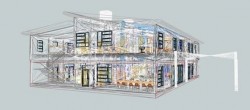The NHS is facing additional challenges as it moves towards delivering a 24/7 service. With patient welfare at the top of everyone’s agenda, building for the future has never been as important as it is now. An increasing and ageing population, coupled with escalating costs, are putting a huge strain on healthcare budgets.
Building Information Modelling (BIM), together with offsite construction techniques, affords quicker, informed decisions about building for the future. With many NHS trusts across the UK in debt and facing unprecedented financial challenges, the introduction of BIM offers some hope for estates managers looking to deliver savings, whilst lifting building quality, as Jim Gowan, design manager at Actavo | Building Solutions, explains:
The BIM treatment
Simply put, BIM is an NHS estate manager’s dream. The holistic answer to the construction industry’s unrelenting question of how to build everything and anything more safely and faster, BIM achieves higher quality standards more cheaply and, when coupled with offsite construction, creates even greater efficiencies.
BIM relies heavily on better planning and design, so a building can perform to the highest standard throughout its lifecycle, from concept to demolition.
In one model, BIM pulls everything together – stakeholders’ opinions, optimising environmental performance, supply chain management and identifying clashes early in the construction process.
What’s more, the government is leading the way – a main contractor builder tendering for a public building must have BIM Level 2 fully engrained into their business.
BIM4Health in practice
The NHS has a responsibility to account for its assets and the launch of BIM4Health, in November 2014, was a key step towards greater transparency.
BIM4Health’s focus is on BIM Level 2 and getting the supply chain to shift from a culture of independence towards one of collaboration – which is what BIM is all about. Combining the expertise of every party through one 3D, integrated, digital model to optimise a building’s performance, BIM results in a greater whole-life cost value of the asset, from a building’s primary use to how that may change over time. The upfront cost is clear and the savings to be made in the future are transparent.
3D visualisation of what a new build will look like, its environmental performance and savings made throughout a building’s life, enables estates managers to see beyond bricks and mortar and the possibility of modular methods.
Time is of the essence in the healthcare sector and we will see a shift from traditional building methods to the quick design and delivery using offsite construction. For example, a small outpatient or specialist treatment facility can be operational after just one month’s onsite works, whereas a traditional build programme generally takes upwards of 26 weeks.
BIM brings real opportunity to personalise buildings to meet not just sustainability and environmental targets. but also the needs of today and the future.
BIM – fits offsite construction better than traditional
Offsite or modular construction methods have often been seen as expensive compared to traditional build – but BIM is a game-changer.
Modular buildings can now be built to any specification – BREEAM, PassivHaus or AECB. As BIM helps extend design life, it can exploit advances in materials and improvements in sustainability and energy efficiency.
Although initial costs are broadly similar, the speed of build and reduced time onsite delivers tangible benefits for modular over traditional build. The whole-life cost and efficiencies weigh in favour of offsite.
Buildings manufactured in factories and assembled onsite make the construction industry safer due to their more controlled environments. They are also faster – just four weeks, in some cases – making it easier for estate and facilities managers to plan and re-direct resources.
The capabilities of offsite more than match traditional build. Patient wards, theatres, A&E departments and cleanrooms can all be designed, built and delivered in 12 weeks, reducing the impact on bed availability and the need for interim short-term hire.
Actavo | Building Solutions was one of the first offsite construction companies to meet BIM Level 2 and it has been fully integrated into the business since July 2015. Instrumental in winning new business, Actavo can showcase the true benefits of offsite build as a quick, cost-effective and high-quality solution.
Original link - BDC Magazine









